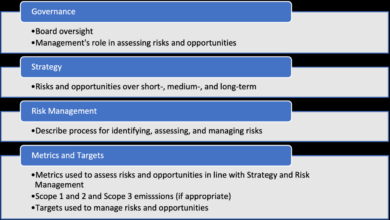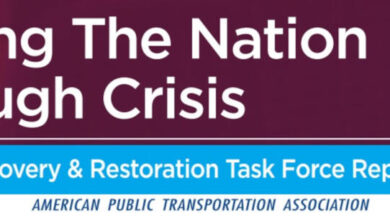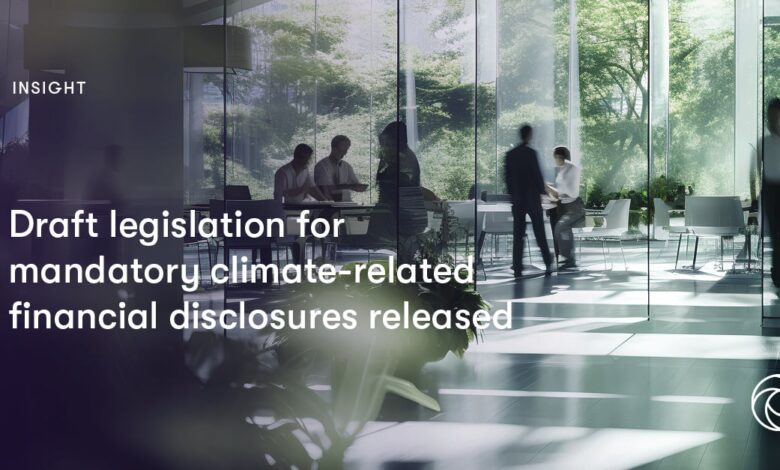
Climate Related Risk Disclosures Reporting A Comprehensive Guide
Climate related risk disclosures reporting is crucial for businesses and investors alike. It’s a vital aspect of understanding and mitigating the impact of climate change on financial performance. This comprehensive guide delves into the intricacies of these disclosures, from defining different types of climate risks to examining best practices in reporting and stakeholder engagement.
The evolving regulatory landscape necessitates clear understanding of reporting frameworks like TCFD. This report examines the challenges in collecting and measuring climate-related data, highlighting the importance of accuracy and consistency. It also explores the disclosure practices of various industries, analyzing trends and common shortcomings.
Introduction to Climate-Related Risk Disclosures: Climate Related Risk Disclosures Reporting
Climate-related risks are no longer a niche concern; they are a fundamental factor impacting businesses, investors, and governments globally. Understanding and disclosing these risks is crucial for informed decision-making and sustainable development. This blog post dives into the world of climate-related risk disclosures, exploring their significance, the evolving regulatory landscape, and the different types of risks involved.Climate-related risk disclosures are the process of publicly revealing a company’s exposure to the financial impacts of climate change.
These disclosures are critical for stakeholders to understand the potential risks and opportunities presented by a changing climate. Investors, in particular, rely on this information to assess the long-term viability and sustainability of companies, while companies need them to identify vulnerabilities and proactively adapt to the changing environment. Furthermore, regulators are increasingly demanding these disclosures to ensure transparency and accountability.
Definition of Climate-Related Risk Disclosures
Climate-related risk disclosures encompass the communication of a company’s exposure to climate change-related risks and opportunities. This includes potential impacts from both physical events (e.g., extreme weather) and the transition to a low-carbon economy (e.g., changing regulations). These disclosures allow stakeholders to understand a company’s vulnerability and resilience in a changing climate, enabling more informed investment decisions.
Significance for Stakeholders
Climate-related risk disclosures are vital for various stakeholders. Investors gain insights into a company’s potential financial vulnerability to climate change, aiding their investment decisions. Companies benefit by identifying risks early, proactively adapting to changing conditions, and enhancing their resilience. Regulators, in turn, use these disclosures to enforce regulations, promote transparency, and ensure accountability. For example, investors may avoid companies deemed high-risk in relation to climate change, leading to reduced investment and increased cost of capital.
Conversely, companies that effectively manage climate-related risks can attract responsible investors and maintain long-term value.
Evolving Regulatory Landscape
The regulatory landscape surrounding climate-related risk reporting is evolving rapidly. Numerous organizations and governments are introducing guidelines, standards, and mandatory disclosure requirements. The Task Force on Climate-related Financial Disclosures (TCFD) framework has become a global standard for climate-related disclosures, and more jurisdictions are adopting or adapting these recommendations. For example, the EU’s Sustainable Finance Disclosure Regulation (SFDR) mandates disclosures for companies operating in the EU, pushing for more transparency in sustainability practices.
Types of Climate-Related Risks
Climate-related risks can be categorized into two main types: physical and transition risks. Understanding these distinct categories is crucial for effective risk management.
Physical and Transition Risks
| Characteristic | Physical Risks | Transition Risks |
|---|---|---|
| Nature | Direct impacts from climate events (e.g., floods, droughts, storms). | Risks arising from the shift to a low-carbon economy (e.g., changing regulations, technological advancements). |
| Examples | Increased frequency and intensity of extreme weather events, sea-level rise, changes in temperature and precipitation patterns. | Policy changes affecting fossil fuel use, investments in renewable energy, and technological advancements in energy efficiency. |
| Impact | Direct damage to assets, supply chain disruptions, and business interruptions. | Changes in demand for products, new regulations affecting operational costs, and market shifts in technology. |
| Examples of Sectors Affected | Agriculture, insurance, real estate, and energy. | Energy, transportation, manufacturing, and construction. |
Physical risks directly affect a company’s operations and assets, while transition risks relate to the ongoing shift towards a low-carbon economy. For example, a coastal power plant faces physical risks from rising sea levels and increased storm surges, while a company relying heavily on coal faces transition risks from stricter environmental regulations.
Reporting Frameworks and Standards
Navigating the complexities of climate-related risks requires a structured approach to reporting. Different frameworks and standards provide a common language and set of guidelines for companies to disclose their climate-related impacts and vulnerabilities. This clarity helps investors, stakeholders, and regulators assess the financial implications of climate change.These frameworks go beyond simple descriptions and offer a structured way to evaluate the materiality of climate-related issues, providing a more nuanced understanding of a company’s exposure.
By following these guidelines, companies can present a comprehensive picture of their climate strategy and performance.
Key Reporting Frameworks
Various frameworks have emerged, each with its strengths and weaknesses. Understanding their differences is crucial for selecting the most appropriate framework for a specific company or industry. The Task Force on Climate-related Financial Disclosures (TCFD) is a prominent example, and others, like the Sustainability Accounting Standards Board (SASB), offer industry-specific guidance.
- The Task Force on Climate-related Financial Disclosures (TCFD) provides a globally recognized framework for reporting climate-related financial risks and opportunities. It’s widely adopted due to its comprehensive nature and focus on actionable insights. Companies using the TCFD framework can demonstrate their commitment to managing climate-related risks and opportunities effectively.
- The Sustainability Accounting Standards Board (SASB) develops industry-specific standards for sustainability reporting. These standards provide a detailed framework for reporting on environmental, social, and governance (ESG) issues. By tailoring their disclosures to specific sectors, companies can provide more relevant and focused information for stakeholders in their industry.
Benefits and Limitations of Frameworks
Each framework offers advantages and disadvantages. Careful consideration of these factors is essential for companies choosing the most suitable approach.
- The TCFD framework benefits from its broad applicability across various sectors. Its focus on financial risks and opportunities makes it valuable for investors and financial institutions. However, the framework might require significant upfront effort for some companies to adapt their reporting processes.
- SASB standards provide detailed industry-specific guidance, enabling more precise and targeted reporting. This specificity enhances comparability within a sector. However, the detailed nature of SASB standards can be more challenging to implement, requiring a thorough understanding of the particular industry standards.
Addressing Climate-Related Risks
Reporting frameworks play a vital role in addressing climate-related risks by providing a standardized method for disclosure. This approach promotes consistency and facilitates a more informed understanding of the financial impacts of climate change.
- Frameworks such as TCFD and SASB help companies identify, assess, and manage climate-related risks. By systematically evaluating potential impacts, companies can develop proactive strategies to mitigate risks and capitalize on opportunities.
- Disclosure requirements help stakeholders make more informed decisions, fostering greater transparency and accountability. Investors can better assess a company’s resilience to climate change, and regulators can monitor compliance and identify emerging trends.
TCFD Framework Components
The TCFD framework comprises four key areas for climate-related disclosures. These areas encompass a holistic view of climate-related risks and opportunities.
| Category | Description |
|---|---|
| Governance | Artikels the board’s oversight of climate-related risks and opportunities. It includes establishing clear roles and responsibilities for climate-related strategy. |
| Strategy | Describes the company’s strategies for addressing climate-related risks and opportunities. This involves defining specific goals and actions. |
| Risk Management | Details how climate-related risks are identified, assessed, and managed. This includes procedures for scenario analysis and stress testing. |
| Metrics and Targets | Defines the metrics used to monitor and report on climate-related performance. It includes setting targets and reporting progress toward achieving goals. |
International Standards and Climate Disclosures
International standards play a crucial role in shaping climate-related disclosures. Harmonized standards foster better comparability and enable a more comprehensive understanding of climate-related risks across different companies and regions.
- International standards encourage consistency and transparency in climate reporting. This benefits stakeholders by allowing for a more accurate assessment of risks and opportunities associated with climate change.
- Surveys and Questionnaires: These tools are valuable for gathering quantitative and qualitative data from a large number of stakeholders. For example, companies can use surveys to assess stakeholder awareness of climate risks, their concerns, and their preferred communication channels. This provides valuable insights for tailoring communication strategies.
- Focus Groups and Interviews: These methods allow for in-depth discussions and feedback from stakeholders. Focus groups can help companies understand the nuances of stakeholder perspectives, while interviews offer opportunities for one-on-one interaction and more detailed information.
- Workshops and Seminars: Workshops and seminars are excellent for providing stakeholders with information and insights about climate-related risks. They are effective in fostering a dialogue and building consensus around climate issues. Companies can leverage these platforms to share their strategies and encourage active participation from stakeholders.
- Public Forums and Webinars: These open forums provide a platform for public discussion and engagement on climate-related risks. Public forums are helpful for fostering transparency and trust.
- Social Media Engagement: Social media platforms offer a direct channel for communicating with a broad range of stakeholders. Companies can use these platforms to share information, engage in discussions, and respond to stakeholder concerns.
- Nestlé: Nestlé has been recognized for its ambitious targets and detailed disclosures concerning its greenhouse gas emissions and water management. Their strategy involves setting specific emission reduction goals, investing in renewable energy sources, and implementing water conservation measures throughout their global supply chain. This comprehensive approach, incorporating a detailed analysis of climate-related risks and opportunities across their operations, has been recognized as a positive step in their sector.
- Microsoft: Microsoft has focused on setting ambitious targets for carbon neutrality and developing sustainable supply chains. They are committed to the use of renewable energy in their data centers and are aggressively investing in energy efficiency measures. This commitment, coupled with a detailed disclosure of their carbon footprint and progress towards reduction targets, has strengthened their position in the market.
- BP: While facing criticism in the past, BP has shown improvement in climate-related disclosures. They are moving towards more sustainable energy sources, although their reliance on fossil fuels remains a significant concern. They have detailed their transition strategy and reported on the financial implications of climate change, which shows an awareness of the materiality of climate change to their business.
- Materiality Assessment: Identifying the most significant climate-related risks and opportunities for a specific company is crucial. This assessment should consider the potential financial impacts and the influence on stakeholder decisions.
- Consistent Data Collection and Measurement: Reliable data collection across all relevant operations and supply chains is essential for accurate reporting. Using consistent methodologies and metrics ensures the comparability of data over time.
- Stakeholder Engagement: Companies should engage with their stakeholders, including investors, customers, employees, and communities, to understand their concerns and expectations regarding climate change. This will ensure the relevance and usefulness of the disclosed information.
Data Collection and Measurement

Gathering reliable climate-related data is crucial for effective risk assessment and reporting. The sheer volume and complexity of climate-related factors, along with the evolving nature of these factors, present unique challenges. Accurate and consistent data collection is essential for companies to understand their exposure, develop appropriate mitigation strategies, and ultimately, contribute to a more sustainable future.
Challenges in Data Collection and Measurement
Collecting climate-related data presents numerous challenges. Data availability varies significantly across regions and sectors. Different data sources may use varying methodologies and reporting standards, leading to inconsistencies. Furthermore, many climate-related risks, such as extreme weather events and sea-level rise, are inherently uncertain and difficult to predict with complete accuracy. The sheer volume of data required to comprehensively assess climate risks can be overwhelming, demanding significant resources and expertise.
Methodologies for Assessing Climate-Related Risks
Various methodologies exist for assessing climate-related risks. Physical risk assessments often involve analyzing historical climate data, projecting future climate scenarios, and evaluating the potential impacts on a company’s operations and assets. Transition risks, which relate to the shift towards a low-carbon economy, are assessed through an analysis of evolving regulatory frameworks, technological advancements, and market dynamics. A crucial aspect of these methodologies is the use of scenario analysis, which considers different possible future climate change trajectories to assess a company’s resilience and adaptability.
Quantitative methods, including probabilistic modeling, are also employed to estimate the likelihood and potential severity of climate-related events.
Importance of Data Accuracy and Consistency
Accurate and consistent data is paramount in climate-related risk reporting. Inaccurate or inconsistent data can lead to misleading conclusions, flawed risk assessments, and ultimately, poor decision-making. Companies must establish clear data collection protocols, ensure data quality through validation and verification procedures, and use standardized metrics to maintain consistency across their reports. This rigor ensures that the information presented is reliable and actionable, allowing for effective risk management and stakeholder engagement.
Comparison of Data Collection Methods
| Risk Type | Data Collection Method | Description | Example |
|---|---|---|---|
| Physical Risks (e.g., extreme weather) | Historical weather data, climate models, expert opinions | Gathering past weather records, utilizing climate models to project future scenarios, and incorporating expert knowledge about regional vulnerabilities. | Analyzing historical flood records to estimate the frequency and severity of future floods in a particular region. |
| Transition Risks (e.g., policy changes) | Regulatory filings, policy documents, market trends, expert interviews | Monitoring policy changes, analyzing market trends, and gathering expert insights into evolving regulations. | Tracking the development of carbon pricing policies to estimate the impact on energy-intensive industries. |
| Reputational Risks | Social media analysis, news articles, investor surveys | Monitoring public perception and evaluating stakeholder reactions. | Analyzing news articles and social media conversations to gauge public opinion regarding a company’s environmental performance. |
Metrics for Measuring Climate-Related Risks
Various metrics are used to quantify climate-related risks. Financial metrics, such as the potential impact on a company’s revenues, costs, and assets, are crucial. Physical metrics, like the projected frequency and intensity of extreme weather events, are also important. Furthermore, metrics that assess the resilience of a company’s operations and infrastructure are also vital. A comprehensive approach utilizes a range of metrics to provide a holistic understanding of climate-related risks.
Examples include changes in sales revenue due to extreme weather events, changes in the value of assets due to sea-level rise, and the cost of adapting to changing weather patterns.
Disclosure Practices and Trends
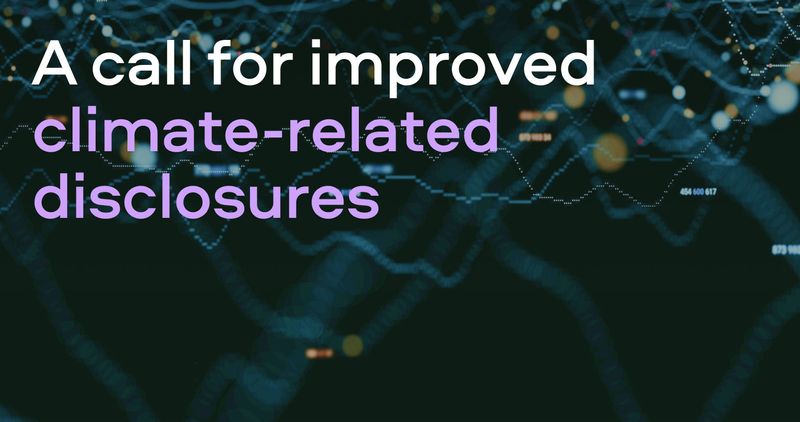
Climate-related risk disclosures are rapidly evolving, driven by growing investor demand and regulatory pressure. Companies are increasingly recognizing the financial implications of climate change, leading to a surge in reporting on their strategies, vulnerabilities, and mitigation efforts. This shift reflects a broader understanding that climate risks are not just environmental concerns but also significant financial factors that need to be integrated into corporate decision-making.
Understanding current disclosure practices, emerging trends, and influencing factors is crucial for stakeholders to assess the effectiveness of these efforts and the potential for future developments.
Current Disclosure Practices Across Industries
Companies across diverse industries are now actively reporting on their climate-related risks and opportunities. Financial institutions, for instance, are disclosing their exposure to climate-related financial risks and the strategies they are implementing to manage them. Energy companies are increasingly detailing their transition plans to a low-carbon economy, including investments in renewable energy sources and carbon capture technologies. Manufacturing companies are also reporting on their emissions, energy consumption, and resource use, demonstrating a growing awareness of their environmental footprint.
Explore the different advantages of cima ethics confidentiality rules that can change the way you view this issue.
This widespread adoption of disclosure practices reflects a growing understanding that climate change is a systemic risk that requires a coordinated response from all sectors.
Emerging Trends in Climate-Related Disclosures
Several emerging trends are shaping climate-related risk disclosures. The increasing adoption of standardized reporting frameworks, such as the Task Force on Climate-related Financial Disclosures (TCFD), is a significant trend, aiming to enhance comparability and transparency. Companies are also integrating climate considerations into their overall sustainability strategies, recognizing the interconnectedness of environmental, social, and governance (ESG) factors. Furthermore, the rise of climate-focused indices and ratings is pushing companies to improve their disclosures, as investors increasingly seek to assess the climate performance of companies they invest in.
Obtain recommendations related to how to clearly communicate feedback and expectations that can assist you today.
Factors Influencing Disclosure Decisions
Several factors influence companies’ decisions to disclose climate-related information. Regulatory mandates and investor pressure are strong drivers. Growing awareness of climate risks among stakeholders, including investors, customers, and employees, also plays a significant role. The desire to enhance corporate reputation and build trust with stakeholders is another influential factor. Finally, the potential for financial benefits, such as attracting investment or reducing operational costs through efficiency gains, can motivate companies to proactively disclose their climate-related data.
Regional Variations in Disclosure Practices
There are noticeable regional variations in climate-related disclosure practices. European Union (EU) regulations, for instance, are driving more extensive disclosures compared to some regions in Asia. Differences in legal frameworks, cultural norms, and investor preferences contribute to these variations. Developing countries may face unique challenges in implementing robust disclosure practices, often due to resource constraints and varying levels of institutional capacity.
Comparative analysis of regional disclosure practices is crucial to understanding the global landscape of climate-related risk reporting.
Do not overlook the opportunity to discover more about the subject of finance departments evolving while bracing for coronavirus second wave.
Shortcomings in Current Reporting Practices
Despite the increasing adoption of climate-related risk disclosures, several shortcomings persist. Inconsistency in reporting standards and methodologies across different companies and industries hinders comparability. The lack of standardized metrics for assessing climate-related impacts can make it difficult to accurately measure and assess risks. Finally, the absence of clear guidance on the disclosure of transition risks and opportunities can lead to incomplete or ambiguous reporting.
Addressing these shortcomings is crucial for ensuring the effectiveness of climate-related risk disclosures.
Stakeholder Engagement and Communication
Climate-related risk disclosures are not a one-way street. Effective communication and engagement with stakeholders are crucial for the credibility and impact of these reports. Understanding stakeholder needs and incorporating their feedback is vital for driving meaningful change and building trust. This section explores the importance of stakeholder engagement in shaping climate-related disclosures and the best practices for communicating effectively with investors, regulators, and the public.Stakeholder engagement is more than just a checkbox; it’s a dynamic process of listening, learning, and adapting.
Companies must understand that their stakeholders – investors, employees, customers, communities, and even governments – have varying levels of knowledge and concern about climate change. Therefore, tailoring communication strategies to resonate with diverse audiences is paramount.
Role of Stakeholders in Shaping Disclosures
Stakeholders play a pivotal role in shaping climate-related risk disclosures. Investors, for example, use these disclosures to assess the financial implications of climate change and to make informed investment decisions. Regulators use these disclosures to understand the extent of climate risks and to develop policies to mitigate them. Communities and employees are increasingly interested in understanding a company’s commitment to sustainability and its impact on the environment.
These diverse perspectives contribute to a comprehensive understanding of climate-related risks and inform more robust and impactful disclosures.
Best Practices for Communicating Climate Risks
Effective communication is key to conveying climate-related risks accurately and transparently. This involves using clear and concise language, avoiding jargon, and providing supporting data and evidence. Visualization tools, such as charts and graphs, can help to present complex information in a digestible format. Furthermore, companies should consider the different communication channels that resonate with their various stakeholders, including websites, investor presentations, and social media.
Consistent communication across all channels helps maintain a unified message.
Importance of Transparency and Accessibility, Climate related risk disclosures reporting
Transparency and accessibility are essential components of effective climate-related risk disclosures. Companies should strive to provide clear and comprehensive information on their climate-related risks and opportunities, while ensuring the information is readily accessible to all stakeholders. This includes using clear language, avoiding technical jargon, and making disclosures available on their websites in multiple formats, including downloadable documents and summaries.
Ensuring disclosures are accessible to those with disabilities is also critical for inclusivity.
Methods of Stakeholder Engagement
Effective stakeholder engagement requires a variety of methods. Different methods resonate with different stakeholder groups.
Incorporating Stakeholder Feedback
Companies should establish mechanisms for collecting and acting on stakeholder feedback. This includes creating feedback forms on company websites, setting up dedicated email addresses for climate-related inquiries, and actively participating in industry forums and conferences. The feedback received should be analyzed to identify trends and concerns, and incorporated into the disclosure process. Companies can use this information to improve their understanding of climate-related risks and opportunities, and to refine their communication strategies.
| Engagement Method | Description | Benefits |
|---|---|---|
| Surveys | Gathering data from a large group | Quick data collection, cost-effective |
| Focus Groups | In-depth discussions with smaller groups | Detailed insights, nuanced understanding |
| Workshops | Interactive sessions with stakeholders | Building relationships, sharing knowledge |
| Public Forums | Open discussions with broad audiences | Transparency, building trust |
Future Outlook and Potential Developments
The future of climate-related risk disclosures is poised for significant evolution, driven by intensifying pressure from stakeholders, technological advancements, and evolving regulatory landscapes. Companies are increasingly recognizing the crucial link between environmental performance and long-term financial viability. This necessitates a proactive approach to understanding and disclosing climate-related risks. The journey towards comprehensive and reliable disclosures is far from over, but the direction is clear: greater transparency and sophistication.The demand for greater transparency and accountability in climate-related reporting will continue to rise.
Investors, regulators, and the public are demanding more robust information to assess the financial implications of climate change on companies. This heightened scrutiny will propel companies to adopt more sophisticated disclosure methods and reporting frameworks.
Predictions about the Future of Climate-Related Risk Disclosures
The trend towards more granular and comprehensive climate-related risk disclosures will intensify. Companies will be expected to move beyond basic reporting of emissions to encompass a broader range of climate-related impacts, including supply chain vulnerabilities, transition risks, and physical risks. This deeper level of detail will provide stakeholders with a more nuanced understanding of a company’s exposure to climate change.
For example, a company’s detailed description of the risks related to a changing regulatory environment regarding emissions targets will prove to be beneficial.
Potential Impacts of Technological Advancements on Reporting Practices
Technological advancements will significantly impact climate-related reporting practices. The rise of AI and machine learning could automate data collection and analysis, enabling companies to generate more precise and comprehensive risk assessments. Furthermore, blockchain technology could enhance the traceability and verification of data, fostering trust and credibility in reporting. Real-time data feeds will be increasingly important in providing a continuous view of environmental performance.
Potential Regulatory Changes in the Future
Future regulatory changes will play a critical role in shaping climate-related risk disclosures. Regulations may mandate specific disclosure requirements, standardize reporting frameworks, and impose penalties for non-compliance. Examples include mandatory climate risk assessments for companies operating in specific sectors, or increased scrutiny of companies’ greenhouse gas emission reductions plans. Expect further regulatory clarity and stricter enforcement to drive greater corporate accountability.
Emerging Innovations in Disclosure Methods
Innovative disclosure methods are emerging, promising greater transparency and accessibility. These include interactive dashboards, virtual reality simulations, and integrated reporting frameworks that seamlessly merge climate information with financial performance. Interactive maps that visually represent a company’s vulnerability to physical climate risks could provide stakeholders with a compelling narrative. This emphasis on visualization and engagement is crucial for effective communication.
Potential Future Trends in Climate-Related Risk Disclosures
| Trend | Description | Impact |
|---|---|---|
| Increased Granularity | Moving beyond basic emissions reporting to encompass broader climate impacts, including transition and physical risks. | Improved stakeholder understanding of company’s exposure to climate change. |
| Technological Integration | Leveraging AI, machine learning, and blockchain to automate data collection, analysis, and verification. | Enhanced accuracy, efficiency, and transparency in reporting. |
| Standardized Frameworks | Adoption of universally accepted reporting frameworks and methodologies. | Improved comparability and reliability of disclosures. |
| Enhanced Stakeholder Engagement | More interactive and accessible disclosures using visualizations, simulations, and integrated reporting. | Increased stakeholder engagement and understanding of climate risks. |
Examples of Effective Reporting
Climate-related risks are no longer a niche concern; they’re a critical factor in investment decisions and corporate strategy. Effective reporting on these risks demonstrates a company’s commitment to sustainability and transparency, potentially attracting investors and customers who prioritize ethical and environmentally conscious businesses. A strong disclosure strategy can also help companies anticipate and mitigate potential financial impacts. Effective climate-related disclosures go beyond simply acknowledging the issue; they involve a comprehensive assessment of the risks and opportunities, a detailed plan for addressing them, and a clear communication strategy.
This often involves not just reporting on emissions, but also on the potential impacts of climate change on supply chains, operations, and financial performance.
Case Studies of Effective Climate Risk Reporting
Companies that are successfully incorporating climate risk into their reporting are often those that employ a holistic approach. They move beyond superficial reporting and delve into the materiality of climate change on their business.
Strategies for Effective Reporting
Several key strategies can enhance climate risk reporting.
Comparing Disclosure Strategies
| Disclosure Strategy | Effectiveness (High/Medium/Low) | Explanation |
|---|---|---|
| Comprehensive Materiality Assessment | High | Thorough evaluation of climate risks and opportunities helps prioritize disclosure efforts and demonstrate a robust understanding of the issue. |
| Detailed Data Collection & Measurement | Medium | Reliable data is critical but may require significant resources and expertise. |
| Stakeholder Engagement & Transparency | High | Building trust and demonstrating accountability through open communication and dialogue enhances the credibility of disclosures. |
Final Summary
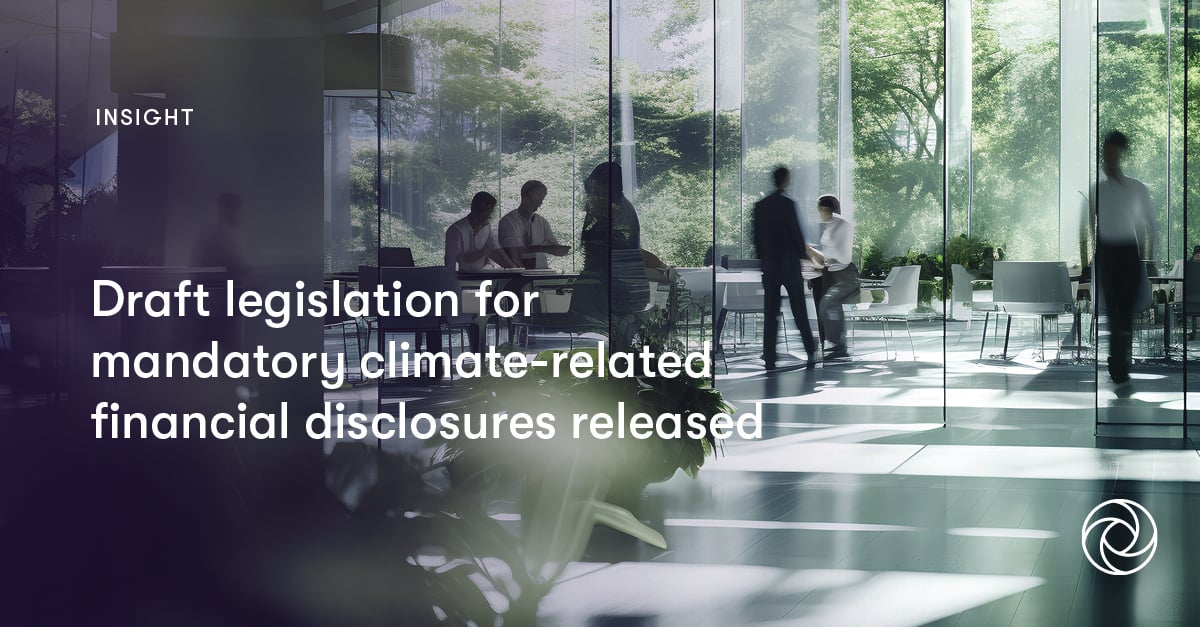
In conclusion, climate related risk disclosures reporting is no longer optional but a critical component of responsible business practices. As the regulatory environment continues to evolve, companies need to adapt their reporting strategies to ensure transparency and stakeholder engagement. This guide provides a roadmap for navigating the complexities of climate-related risks and effectively communicating their impact to investors and other stakeholders.


